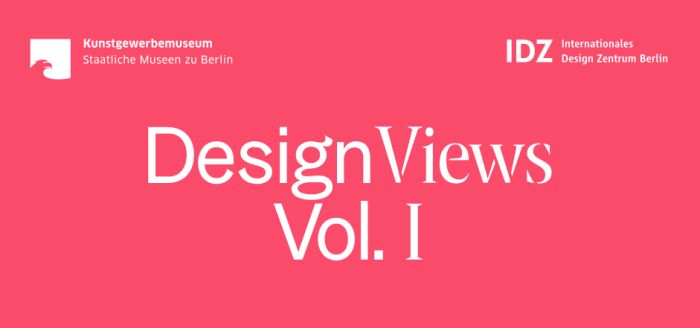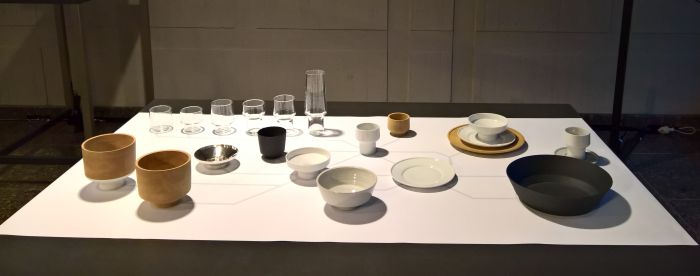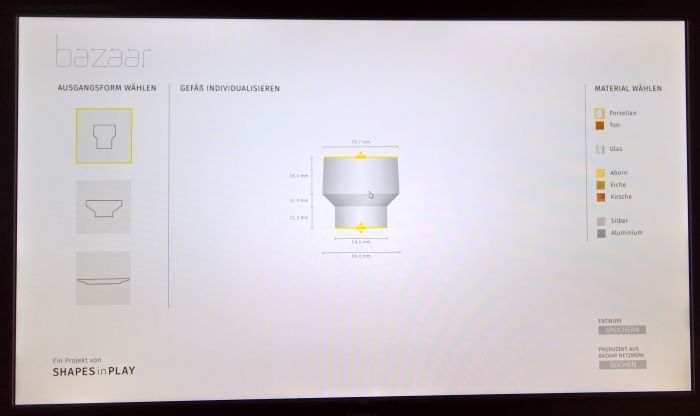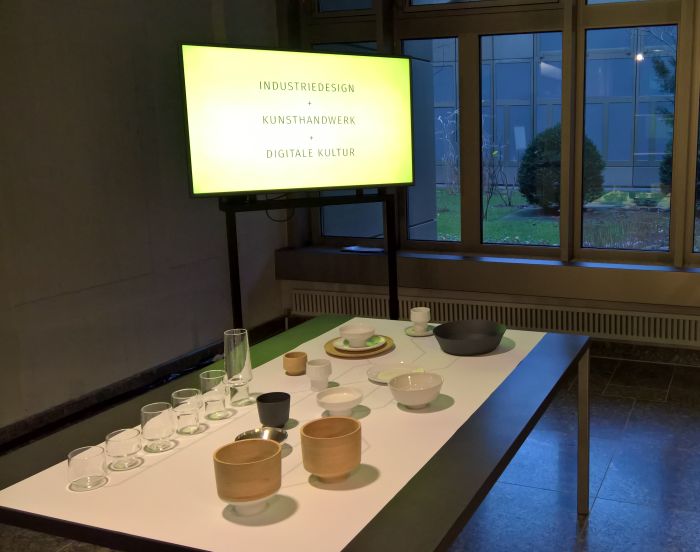By way of an addendum to our 5 New Architecture & Design Exhibitions for February 2018 post, and arguably also to save us mentioning it every month, February 2018 sees the inauguration of a new design exhibition cycle in Berlin: Design Views, a cooperation between the Internationale Design Zentrum Berlin and the Kunstgewerbemuseum Berlin initiated with the aim of highlighting contemporary developments, thinking and directions in design.

2018 marks the 150th anniversary of the Kunstgewerbemuseum Berlin and the 50th anniversary of the Berlin based Internationales Design Zentrum, IDZ, and whereas anniversaries are traditionally moments to reflect backwards, the IDZ and Kunstgewerbemuseum decided to combine their resources, their depth of experience, and use their anniversaries as an impetus to jointly reflect forward.
"I had been considering establishing a platform for current design, one which didn't just present design but which offered a possibility to come into conversation with the designers", explains the IDZ's Head of Research, Ingrid Krauß the genesis of the project, "last summer Claudia Banz took up the post of Design Curator at the Kunstgewerbemuseum and planned something similar involving recent graduates from the Berlin design schools, and so it was a logical conclusion to bring the two ideas together and develop a joint platform for contemporary design, to ask, for example, where is design currently? In which directions is it moving?"
To this end Ingrid Krauß and Dr. Claudia Banz have invited/will invite selected design studios to present a project in the Kunstgewerbemuseum, each project being on display for three weeks, whereby, important and interesting for us is that the projects will be integrated within the museums permanent exhibition; the designers and curators selecting a location where an appropriate, meaningful, dialogue can be staged between the museum's collection and the studio's work.
Interesting because it means the museum visitor will arrive unprepared at the projects, stumble across them almost, and therefore potentially arrive at them more open to not only the studios' work but also to the new perspective (hopefully) bequeathed on the museum's collection. And important because, and as we've oft noted in these pages, museums should, must, play a role in discourses on the future as much as being locations for collecting, preserving and presenting the past. Not least because if we consider the helical nature of existence means reflections on the future are simply interpretations of the past, where better to reflect than in a museum.
And it is what museums originally did.
The first museums being in many regards extensions of the famed cabinets of curiosities, were, largely, locations where the new, the novel, the "exotic" was presented, while, and as discussed in context of the Werkbundarchiv – Museum der Dinge Berlin's exhibition Object Lessons, the first Applied Art Museums were essentially show collections, places where those with an interest could go and learn about different materials, different minerals, different cultures' approaches to universal problems, and thereby not only expand their knowledge but also facilitate considerations on new possibilities, new futures.
Pleasingly with Design Views the stated aim of the IDZ and the Kunstgewerbemuseum is only to present projects which demonstrate new thinking, experimental materials, alternative approaches, and which in doing so help us move towards new understandings and therefore facilitate considerations on new possibilities, new futures.
Something neatly demonstrated by the first Design Views project, Bazaar by Berlin studio SHAPES iN PLAY a.k.a Johanna Spath and Johannes Tsopanide

While the obvious focus of the presentation is a collection of vases, bowls, plates and glasses assembled on a table, the more interesting part is the less obvious computer standing behind the table. In essence Bazaar starts with three archetypal forms, the user can adjust them in height and diameter, choose a material, creating thereby their own individual object, and then, which is were the project gets interesting, select a producer to create them.
And before anyone starts pointing fingers and claiming that such is exactly the "design your own trainers" marketing nonsense which regularly brings us out in an apoplectic rage, there are a few fundamental differences. Not least the trainers are all pre-produced, sitting round in huge warehouses waiting to shipped globally. All you are doing is selecting from a few narrow parameters. i.e. nothing. With Bazaar the object doesn't exist until you create it, and in choosing a local producer you can not only help strengthen local economies but also sidestep resource heavy global distribution networks.
Both good.
In addition Bazaar is also an interesting development of the Open Source approach. As we've previously noted, a major issue in context of Open Source design is that most of us simply have neither the time, skills nor inclination to build objects ourselves. But if you can create something, and then in the same process find a local specialist who can produce it for you, so much the better. Here it's tableware/accessories, in the future it could also be furniture, clothing or even housing.
As a project Bazaar also raises a few interesting questions about form and aesthetics. Using SHAPES iN PLAY's system you can create, for example, a vase through adjusting the diameter and height of an pre-existing, pre-defined form. But are we all capable of thereby producing well formed, aesthetically pleasing, objects? If, for example, the Golden Ratio has any relevance, how many of us can correctly judge the correspondence between the diameter of the opening to the height of the stem? And do all objects work equally well in all materials? Is that not why we need designers? Or are such considerations overrated? Are the majority of us as unskilled in assessing physical forms as we are in reading music, combining colour, forming sentences, and tend to find joy in just, like, you know, so..... whatever?
Such discussions are important in, for example, considerations on how computer technology and digitalisation are best integrated into future design and production processes, and as a project Bazaar offers some interesting insights.
And a satisfyingly uncomplicated system for realising your own unique home accessories.
For 2018 Ingrid Krauß and Claudia Banz plan to present exclusively Berlin based design studios, logical given the location and the number of interesting Berlin based studios, aren't however adverse to opening it up geographically in the future, and there are also considerations on developing accompanying fringe programmes, whereby the first such event arguably already exists: each showcase begins with a Vernissage, always the last Wednesday of the month, and thereby a monthly social gathering for all in/near Berlin with an interest in contemporary design. Thus making Design Views not just an exhibition but a platform in Berlin to help further the discourse and dialogue in context of contemporary design.
And therefore a platform we are certain would have appealed to the founders of the Kunstgewerbemuseum and the Internationale Design Zentrum.
Bazaar by SHAPES iN PLAY can be viewed at the Kunstgewerbemuseum Berlin, Matthäikirchplatz, 10785 Berlin until Wednesday February 21st.
The Design Views cycle continues with Wooden Textiles by Elisa Strozyk, Composing Processes by Philipp Weber, Circular. Fashion by Ina Budde, Ideal und Mode by Natascha von Hirschhausen, before in late June/early July chmara.rosinke round up the first half of 2018 with Out of the Workshop. Future showcases will be announced anon.
Further details on Design Views can be found at both http://idz.de and www.smb.museum and further details on Bazaar at www.shapesinplay.com

